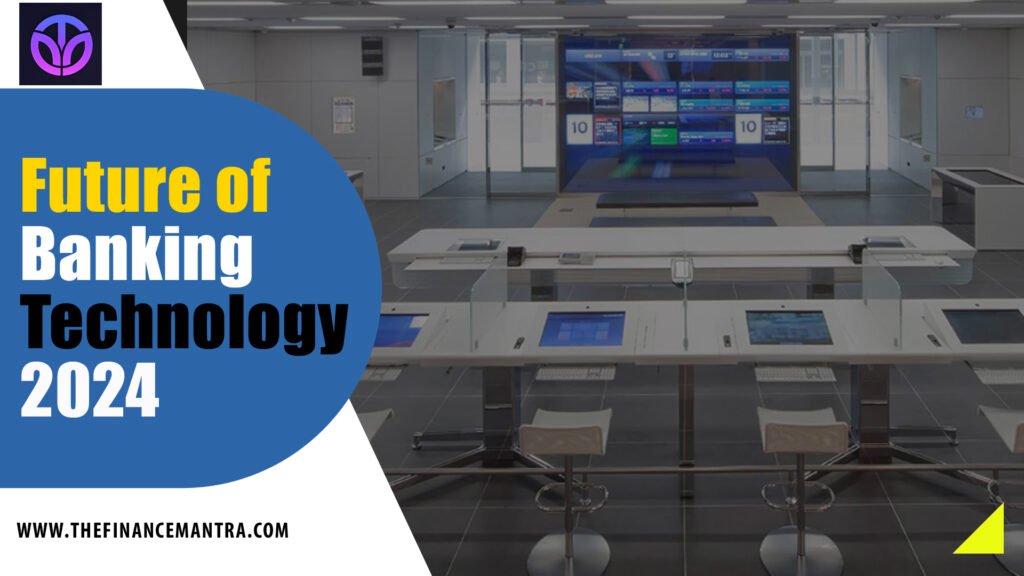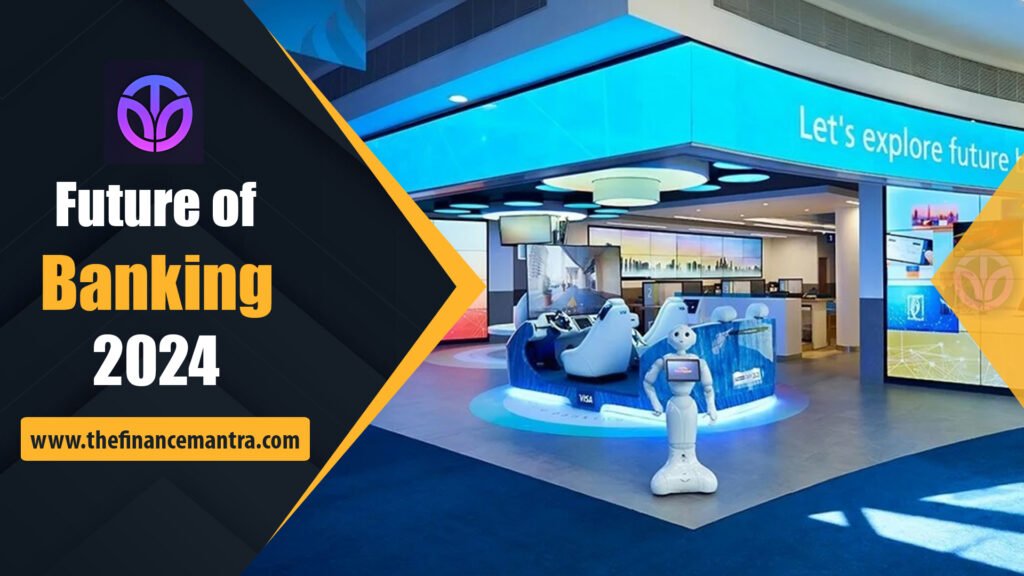Future of Banking: Banking technology has evolved rapidly over the past few decades, transforming the way we manage, spend, and save money. With advances in digital innovation, the future of banking technology promises even more transformational changes. In this article, we explore the trends, innovations and high-impact areas that will shape the future of banking technology, highlighting key developments that could move the financial industry forward.
The Rise of Digital Banking
Mobile Banking: Convenience at Your Fingertips
Future of Banking: Mobile banking has revolutionized the banking experience by giving customers the ability to manage their finances on the go. The future of mobile banking is set to be even more seamless and integrated. As smartphones become more powerful and ubiquitous, mobile banking apps will continue to offer advanced features such as instant account access, real-time notifications, and personalized financial advice.

Neobanks: The New Age of Banking
Neobanks, or digital-only banks, are set to redefine the banking landscape. Without physical branches, these banks offer a fully digital experience, often with lower fees and innovative services. As neobanks gain popularity, traditional banks are being forced to improve their digital offerings to stay competitive.
Artificial Intelligence and Machine Learning
Personalized Banking Experiences
Future of Banking: Artificial Intelligence (AI) and Machine Learning (ML) are transforming banking by enabling personalized customer experiences. AI-driven chatbots and virtual assistants provide instant support, answer queries, and offer financial advice tailored to individual needs. These technologies also help banks analyze customer data to offer customized products and services.
Fraud Detection and Prevention
AI and ML play a crucial role in enhancing security and preventing fraud. By analyzing transaction patterns and detecting anomalies, these technologies can identify potential fraud in real-time, protecting both customers and banks. This proactive approach to security helps build trust and ensures a safer banking environment.
Blockchain and Cryptocurrencies
Blockchain: The Backbone of Future Transactions
Future of Banking: Blockchain technology is set to revolutionize the way transactions are conducted and recorded. By providing a secure, transparent, and immutable ledger, blockchain ensures the integrity of financial transactions. Banks are increasingly exploring blockchain for cross-border payments, smart contracts, and identity verification.
Cryptocurrencies: The Digital Currency Revolution
Cryptocurrencies like Bitcoin and Ethereum have gained significant traction, and their influence on the banking sector is undeniable. While regulatory challenges remain, the integration of cryptocurrencies into mainstream banking is on the horizon. Banks are exploring ways to offer crypto-related services, such as digital wallets and crypto trading platforms.
Open Banking and APIs
Open Banking: Empowering Customers
Future of Banking: Open banking, driven by regulations like PSD2 in Europe, allows customers to securely share their financial data with third-party providers. This fosters innovation and competition, leading to the creation of new financial products and services. Customers benefit from a more transparent and personalized banking experience.
APIs: Bridging the Banking Ecosystem
Application Programming Interfaces (APIs) are the backbone of open banking. By enabling seamless data exchange between banks and third-party providers, APIs facilitate the development of innovative financial solutions. Banks can offer enhanced services, such as account aggregation, payment initiation, and financial planning tools, through API integration.
Financial Inclusion and Accessibility
Banking the Unbanked
Future of Banking: One of the most significant impacts of future banking technology is the potential to improve financial inclusion. Digital banking solutions can reach underserved populations, providing access to banking services for those previously excluded. Mobile banking, digital wallets, and micro-lending platforms are key drivers of financial inclusion.
Accessible Banking for All
Future banking technology aims to make banking more accessible for people with disabilities. Voice-activated banking, screen readers, and simplified user interfaces are examples of how technology can create an inclusive banking environment. Banks are increasingly focusing on designing services that cater to the needs of all customers.
Fintech Collaboration and Innovation
The Rise of Fintech Companies
Future of Banking: Fintech companies are at the forefront of banking innovation, offering a range of services from payment processing to investment management. Collaboration between traditional banks and fintech firms is becoming more common, driving the development of innovative financial products and services.
The Future of Payments
Payments are undergoing a transformation, with new technologies enabling faster, more secure transactions. Contactless payments, digital wallets, and peer-to-peer payment platforms are gaining popularity. The future of payments will likely see the integration of biometric authentication and blockchain technology to enhance security and convenience.
Cybersecurity and Data Privacy
Enhancing Cybersecurity Measures
Future of Banking: As banking technology advances, so do the threats. Banks must invest in robust cybersecurity measures to protect customer data and prevent cyberattacks. Advanced encryption, multi-factor authentication, and biometric security are essential components of a secure banking environment.
Prioritizing Data Privacy
Data privacy is a critical concern for both banks and customers. With the increasing use of data analytics and AI, banks must ensure that customer data is handled responsibly. Compliance with data protection regulations, such as GDPR, and transparent data practices are crucial for maintaining customer trust.
Sustainable Banking Practices
Green Banking Initiatives
Future of Banking: Sustainability is becoming a priority for banks as they recognize their role in addressing climate change. Green banking initiatives include offering eco-friendly financial products, investing in sustainable projects, and reducing the carbon footprint of banking operations. Customers are increasingly demanding that banks adopt sustainable practices.
Ethical Banking
Ethical banking goes beyond environmental sustainability, encompassing social responsibility and ethical governance. Banks are committing to ethical lending practices, fair treatment of employees, and support for community development. This shift towards ethical banking is driven by both regulatory pressure and consumer demand.
The Future of Branch Banking
The Evolution of Bank Branches
Future of Banking: While digital banking is on the rise, physical bank branches are not becoming obsolete. Instead, they are evolving to serve new purposes. Future bank branches may focus on providing specialized services, financial advice, and community engagement. The integration of technology within branches will enhance the customer experience.
Hybrid Banking Models
Hybrid banking models, combining digital and physical services, are likely to become more prevalent. Customers can enjoy the convenience of online banking while having access to in-person support when needed. This approach ensures that banks cater to the diverse preferences of their customers.
The Role of Big Data and Analytics
Data-Driven Decision Making
Future of Banking: Big data and analytics are transforming how banks operate and make decisions. By analyzing vast amounts of data, banks can gain insights into customer behavior, market trends, and operational efficiency. This data-driven approach enables banks to make informed decisions, optimize processes, and improve customer satisfaction.
Predictive Analytics for Financial Planning
Predictive analytics uses historical data and machine learning algorithms to forecast future trends. In banking, predictive analytics can help in risk management, customer segmentation, and personalized financial planning. By anticipating customer needs and market shifts, banks can proactively offer relevant solutions.
Biometric Authentication and Identity Verification
Enhancing Security with Biometrics
Future of Banking: Biometric authentication is becoming a standard for securing banking transactions. Technologies such as fingerprint scanning, facial recognition, and voice recognition provide a higher level of security compared to traditional passwords. Biometric authentication also offers a seamless and convenient user experience.
Digital Identity Verification
Digital identity verification is crucial for preventing fraud and ensuring compliance with regulatory requirements. Banks are adopting advanced identity verification methods, including document scanning and AI-based identity checks. These technologies enhance the onboarding process and reduce the risk of identity theft.
The Future of Lending and Credit
AI-Powered Credit Scoring
Future of Banking: Traditional credit scoring models are being augmented by AI-powered systems that analyze a wider range of data points. This allows for more accurate and fair credit assessments, particularly for individuals with limited credit history. AI-powered credit scoring can help banks extend credit to a broader customer base.
Peer-to-Peer Lending Platforms
Peer-to-peer (P2P) lending platforms connect borrowers directly with lenders, bypassing traditional banks. These platforms offer competitive interest rates and flexible lending options. The future of P2P lending will see increased use of blockchain technology and AI to enhance security and efficiency.
Conclusion
Future of Banking: The future of banking technology is full of exciting possibilities that promise to transform the financial industry. From mobile banking and AI-powered personalization to blockchain and biometric authentication, these advances will redefine the way we interact with our finances. As banks continue to innovate and adapt to new technologies, customers can expect a more convenient, secure, and inclusive banking experience. By staying informed about these trends, you can be better prepared to navigate the changing banking technology landscape.
Final Thoughts
Future of Banking: The rapid pace of technological innovation means that the future of banking will likely bring even more unexpected advances. By embracing these changes and leveraging new technologies, banks can not only improve their services but also better meet the needs of their customers. As a consumer, keeping an eye on these trends will help you take advantage of the latest banking innovations and ensure you’re getting the most out of the financial tools and services available.
FAQs: Future of Banking Technology
1. What is digital banking?
Answer: Digital banking refers to the use of digital platforms and technologies to provide banking services. This includes online banking, mobile banking apps, and neobanks which operate entirely online without physical branches.
2. How is artificial intelligence used in banking?
Answer: Artificial intelligence (AI) is used in banking for personalized customer experiences, fraud detection and prevention, risk management, and automating customer service through AI-driven chatbots and virtual assistants.
3. What are neobanks?
Answer: Neobanks are digital-only banks that offer banking services without any physical branches. They typically provide innovative and user-friendly services, often with lower fees compared to traditional banks.
4. How does blockchain technology impact banking?
Answer: Blockchain technology enhances the security, transparency, and efficiency of financial transactions. It is used for cross-border payments, smart contracts, and secure identity verification in banking.
5. What are cryptocurrencies, and how are they related to banking?
Answer: Cryptocurrencies are digital currencies that use cryptographic methods for secure transactions. Banks are exploring ways to integrate cryptocurrencies by offering digital wallets and crypto trading platforms.(Future of Banking: )
6. What is open banking?
Answer: Open banking allows customers to share their financial data securely with third-party providers through APIs. This leads to the development of new financial products and services, fostering innovation and competition in the banking sector.
7. How does mobile banking enhance the customer experience?
Answer: Mobile banking provides customers with the convenience of managing their finances on the go. Features include instant account access, real-time notifications, mobile check deposits, and personalized financial advice.(Future of Banking: )
8. What role do fintech companies play in the banking industry?
Answer: Fintech companies drive innovation in the banking industry by offering a wide range of services such as payment processing, investment management, lending platforms, and financial planning tools. They often collaborate with traditional banks to enhance service offerings.
9. How is cybersecurity evolving in banking?
Answer: Cybersecurity in banking involves advanced encryption, multi-factor authentication, biometric security, and continuous monitoring to protect customer data and prevent cyberattacks. Banks must invest in robust cybersecurity measures to safeguard their systems.
10. What is financial inclusion, and how does technology support it?
Answer: Financial inclusion refers to providing access to affordable financial services to underserved populations. Technology supports financial inclusion through mobile banking, digital wallets, micro-lending platforms, and other digital financial solutions.
11. What are the benefits of biometric authentication in banking?
Answer: Biometric authentication enhances security and convenience by using unique physical characteristics such as fingerprints, facial recognition, and voice recognition to verify identity, reducing the risk of fraud and unauthorized access.(Future of Banking: )
12. How does predictive analytics benefit banking?
Answer: Predictive analytics uses historical data and machine learning algorithms to forecast future trends. In banking, it helps with risk management, customer segmentation, personalized financial planning, and improving customer satisfaction by anticipating needs.
13. What are the challenges of integrating cryptocurrencies into mainstream banking?
Answer: The challenges include regulatory uncertainties, volatility of cryptocurrencies, security concerns, and the need for robust infrastructure to support crypto transactions. However, banks are exploring ways to overcome these challenges and offer crypto-related services.
14. How are banks addressing data privacy concerns?
Answer: Banks address data privacy concerns by complying with data protection regulations such as GDPR, implementing transparent data practices, and using advanced security measures to protect customer information from breaches and unauthorized access.
15. What is the future of bank branches in the digital age?
Answer: While digital banking is on the rise, physical bank branches are evolving to focus on specialized services, financial advice, and community engagement. Hybrid banking models that combine digital and physical services are likely to become more prevalent.(Future of Banking: )
16. How is AI transforming credit scoring?
Answer: AI-powered credit scoring models analyze a broader range of data points, providing more accurate and fair assessments of creditworthiness. This helps banks extend credit to individuals with limited credit history and reduces bias in lending decisions.
17. What are peer-to-peer lending platforms?
Answer: Peer-to-peer (P2P) lending platforms connect borrowers directly with lenders, bypassing traditional banks. These platforms offer competitive interest rates and flexible lending options, with increased use of blockchain and AI for security and efficiency.
18. What are green banking initiatives?
Answer: Green banking initiatives focus on sustainability, including offering eco-friendly financial products, investing in sustainable projects, and reducing the carbon footprint of banking operations. These initiatives align with the growing consumer demand for environmentally responsible practices.
19. How do APIs facilitate open banking?
Answer: APIs (Application Programming Interfaces) enable seamless data exchange between banks and third-party providers, allowing for the development of innovative financial solutions. They are essential for implementing open banking by providing secure and standardized access to financial data.
20. What is ethical banking?
Answer: Ethical banking involves practices that go beyond environmental sustainability, including social responsibility, ethical governance, and fair treatment of employees and customers. Banks commit to ethical lending practices and support community development initiatives.


